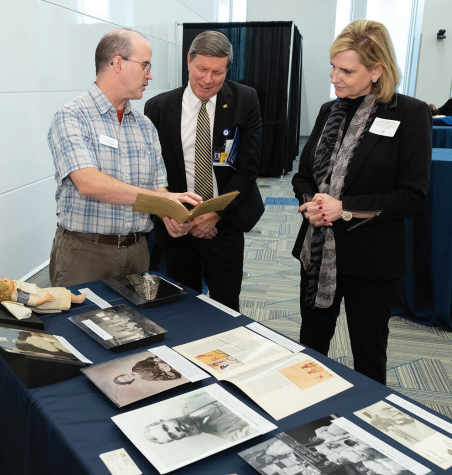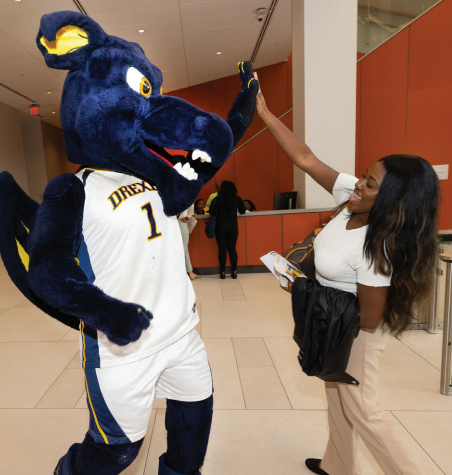What’s It Like to Move a Medical School?
Academic Year Starts at Health Sciences Building
By Andrea Dawson
On August 14, more than 400 first- and second-year medical students, along with over 150 Drexel University College of Medicine faculty and staff, began the academic year not at the familiar Queen Lane Campus in East Falls. They began it 6 miles south, in a gleaming, 12-story tower — a newly constructed marvel known as the Health Sciences Building — in the heart of University City.

Much fanfare has accompanied the relocation, which brings together medical students with students from the Graduate School of Biomedical Sciences and Professional Studies as well as the College of Nursing and Health Professions. But what do students, faculty and staff make of the move?
Here, several of them reflect on Queen Lane sentimentality, relocation logistics, newfound advantages and the expanded community that awaits them at the Health Sciences Building.
Safeguarding History

At a September welcome event, Legacy Center archivist Matt Herbison shared archival materials with attendees, including Dean Charles B. Cairns, MD, and Senior Vice Dean for Faculty Nancy Spector, MD.
Before she became a Drexel faculty member, Dana Farabaugh, MD, senior associate dean of medical education and professor of obstetrics and gynecology, was a Drexel medical student. It’s no surprise that the Queen Lane Campus, where she began her studies, evokes nostalgia. “Teaching classes in the same rooms where you sat as a student was a unique experience. I’ll miss that,” she says.
Relocating the medical school to University City was not simply a geographical shift. It was a separation — particularly for faculty — from accumulated memories, not to mention from a powerful campus history. The Queen Lane Campus was originally home to the Medical College of Pennsylvania, founded in the 1850s as the Female Medical College of Pennsylvania, the first degree-granting medical school for women in the world. Also central to the campus’s history was Hahnemann University, founded in 1848 as the Homeopathic Medical College of Pennsylvania, the country’s first medical school focused on homeopathy. In 2002, halfway through Farabaugh’s time as a student, Drexel officially assumed management of the two entities, giving rise to Drexel University College of Medicine.
Preserving this groundbreaking health science history is top of mind for Margaret Graham, director of the Legacy Center Archives and Special Collections. Located at the Queen Lane Campus, it houses the school’s records and heritage. “From a historical perspective, the relocation is less about moving away from Queen Lane and more about bringing the history of the school to the Health Science Building,” she explains. “My goal is to keep that history visible so it’s not lost.”
To that end, she and others in the Legacy Center were hard at work over the summer creating a temporary mural project, currently on display on the first, second, third, ninth and 12th floors of the building. While there are no immediate plans for the Legacy Center to join in the move to University City, Graham looks forward to partnering with a diverse advisory group as well as others in the College of Medicine community to create a more permanent archival installation.
Where Will We Park?
With such a major change to routines, there were uncertainties about parking and commuting. Farabaugh recalls, “We were very comfortable and familiar with East Falls, and change can be hard.”
Emerson Rowe, MD ’26, who opted to remain living in East Falls after the relocation, remembers that the idea of the Health Sciences Building — and access to one of the most state-of-the-art medical facilities in the Northeast — was highlighted when he applied to Drexel. As the move drew closer, he and his classmates started to consider the implications. “We were curious about the logistics, wondering how we would commute, where we would take exams, if we would have access to the same libraries,” he recalls.
In anticipation of the transition to the new building, Shray Jain, MD ’26 moved from East Falls to Center City in June. As a first-year, he got to Queen Lane for classes within minutes. Now, using the Dragon Route shuttle, he arrives at the Health Sciences Building in about 25 minutes. The longer commute is worth it, he says. “I was excited to move to a different environment. Here, we get exposure to more of the city. And there’s definitely excitement to see what the new building can offer.”
At Home in the Health Sciences Building
FAVORITE HEALTH SCIENCES BUILDING STUDY NOOKS
“Restaurant-style” study booths on the fourth floor.
Shray Jain, MD ’26
Large conference room in the far corner of the ninth floor, where he can watch the sun set over the city.
Talmadge Gaither, MD ’26
Still visits the Queen Lane library, on occasion.
Emerson Rowe, MD ’26
Depending on who you ask, moving into the 460,000-square-foot building was either seamless or logistically complex. For faculty, crates were delivered to Queen Lane offices, and essential files and computers were loaded in. A few days later, everything was neatly delivered to newly furnished offices in the Health Sciences Building.
For Tiffany Davis, EdD, director of the Clinical Education Assessment Center (CEAC) and Standardized Patient program, the move was years in the making. With oversight of the operation and staffing of mock exam rooms in which students practice their clinical skills, Davis was on the building’s Planning and Building Committee for two years leading up to the move. She and her team wanted to ensure the new CEAC training space was custom designed to meet students’ needs. While most furniture is new, some chairs, exam tables, and other supplies and medical equipment had to be packed up, carted downtown and rearranged in the CEAC’s new space. Now, students have a total of 18 exam rooms at their disposal, up from 13 at Queen Lane, where they often had to share space with the Simulation Center. The room increase, not to mention their modern, bright appearance and improved air circulation, are significant improvements, Davis says. Indeed, the massive windows channeling ample natural light are routinely cited as a welcome feature of the Health Sciences Building.
Another notable attribute of the location, which students are quick to cite: Easy access to an array of food options, including a Dunkin’ Donuts beside the Health Sciences Building’s entrance and an airy café just inside its lobby. Still, Rowe remembers experiencing some degree of culture shock, transitioning from a homey, suburban campus teeming with inviting flower beds to a vibrant metro area. It wasn’t long before he was won over. With a background in physical therapy and an interest in pursuing orthopedic surgery, Rowe is particularly impressed by the new anatomy lab and bone room, both on the 12th floor. Where Queen Lane’s dissection space was basement-level, the Health Sciences Building’s is light-filled and capacious, with oversized touch screens that allow for intricate 3D dissections. Beside the lab, a bone room filled with 3D-printed models and bone boxes containing every piece of human anatomy allow for careful examination and practice. “Having this level of access to anatomic resources is a huge asset,” he says.
Talmadge Gaither, MD ’26, who plans to focus his medical training in urology, cites proximity to the resources of University and Center City as a significant advantage. “Drexel doesn’t have a home program for urology, so being closer to Penn, Temple and Jefferson makes collaboration a lot easier,” he notes.
With more shared lounge areas and study spaces, collaboration and connection are happening inside the Health Sciences Building, too. Farabaugh points out that at Queen Lane, faculty offices were tucked away on one side of the building, separating them from students. The open layout of the building eases communication and interaction among students and educators, she says. “When you walk through the new building, you see and hear people, there’s space to congregate. You feel like you’re part of a community.”
What’s more, because students and faculty from all three schools are housed in the same building, that sense of community is not only accentuated, but facilitated. For several years Farabaugh has hosted interprofessional educational sessions with the College of Nursing and Health Professions. Given geographical constraints, they have always occurred via Zoom. Now that students share the same space, she’s eager to see those sessions take place in person.
New Community, Greater Impact

Mario the Magnificent was on hand at the Health Sciences Building during MD student orientation to welcome the incoming class of 2027.
To be sure, some aspects of Queen Lane will be missed. Transporting a few beloved items from the old campus to the new has helped to make the new space feel more like home. “We kept the ping pong tables,” jokes Rowe. “That was a must for the medical students. The pool table, too.”
But all in all, as the College’s faculty and staff — the final cohort to occupy the Health Sciences Building — settle in, excitement and promise are palpable.
Gaither, who works at the Legacy Center and has developed a deep appreciation for the College’s history and origins, captures the sentiments of many. “I’m grateful to have experienced the Queen Lane Campus. And I’m equally excited for the opportunity to experience the Health Sciences Building and to be a part of the College of Medicine community as it begins its next chapter.”
That excitement extends to the highest ranks of the school community. Dean Charles B. Cairns, MD, shares, “The opening of the new Health Sciences Building constitutes a momentous milestone for Drexel, one that positions students and faculty more squarely at the forefront of educational opportunity, interprofessional partnership and overall impact. That impact will be noticeable not only within our own school community, but importantly, throughout the Greater Philadelphia area and beyond.”
As a former Queen Lane medical student, Farabaugh can relate to the sense that the East Falls location was separate from the greater Drexel community. Upending those feelings is what excites her most about the College’s new home. “The potential, the opportunity and the experiences that the Health Sciences Building will bring for the students, that’s what I’m really looking forward to,” she says. “Not only educationally, but socially, too, helping them to feel more fully part of the larger Drexel community. The effect of that integration will be tremendously positive for all of us.”
Back to Top